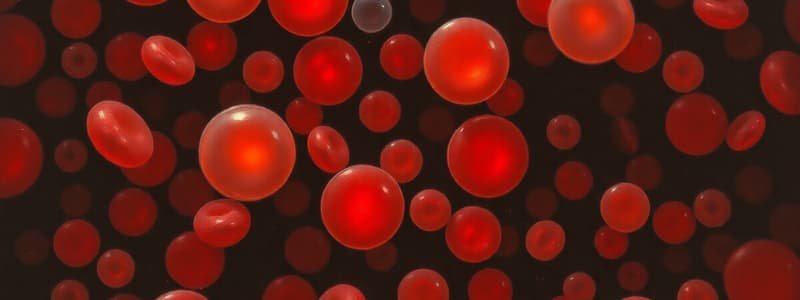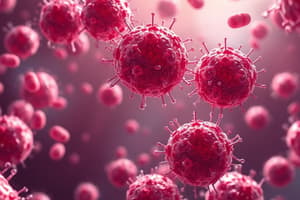Podcast
Questions and Answers
Which of the following is NOT considered a primary defense mechanism facilitated by white blood cells?
Which of the following is NOT considered a primary defense mechanism facilitated by white blood cells?
- Phagocytosis of bacteria
- Initiation of blood clotting (correct)
- Secretion of antibodies by lymphocytes
- Amoeboid motion towards infection sites
What role do tissue macrophages play in the reticuloendothelial system?
What role do tissue macrophages play in the reticuloendothelial system?
- Secreting antibodies into the bloodstream
- Producing histamine and other inflammatory mediators
- Phagocytizing foreign particles and cellular debris within tissues (correct)
- Filtering lymph as it passes through lymph nodes
How does chemotaxis assist white blood cells in combating infection?
How does chemotaxis assist white blood cells in combating infection?
- By attracting white blood cells to the site of inflammation (correct)
- By enhancing the phagocytic activity of macrophages
- By directly neutralizing bacterial toxins
- By increasing the production of white blood cells in the bone marrow
Which of the following best describes the difference in phagocytic capability between neutrophils and macrophages?
Which of the following best describes the difference in phagocytic capability between neutrophils and macrophages?
In the context of infection defense, what is diapedesis?
In the context of infection defense, what is diapedesis?
What is a key characteristic of leukemia?
What is a key characteristic of leukemia?
How do alveolar macrophages contribute to the reticuloendothelial system?
How do alveolar macrophages contribute to the reticuloendothelial system?
Which of the following is a potential cause of leukopenia?
Which of the following is a potential cause of leukopenia?
What is the role of Kupffer cells in the reticuloendothelial system?
What is the role of Kupffer cells in the reticuloendothelial system?
What is the function of pus formation in inflammation?
What is the function of pus formation in inflammation?
Flashcards
Leukocytes
Leukocytes
White blood cells; include neutrophils, eosinophils, basophils, monocytes, and lymphocytes.
Granulocytes
Granulocytes
A type of leukocyte that includes neutrophils, eosinophils, and basophils.
Infection Defense
Infection Defense
The process where neutrophils and macrophages attack and destroy harmful agents.
Phagocytosis
Phagocytosis
Signup and view all the flashcards
Reticuloendothelial System
Reticuloendothelial System
Signup and view all the flashcards
Inflammation
Inflammation
Signup and view all the flashcards
Leukopenia
Leukopenia
Signup and view all the flashcards
Leukemia
Leukemia
Signup and view all the flashcards
Study Notes
- Leukocytes and granulocytes are types of blood cells.
- Module 9 covers Guyton-34, 35 and McCance 9.
- Module 9 learning objectives include describing the hematologic system, understanding blood cell roles in hemostasis, and evaluating hematologic system disturbances.
White Blood Cells (WBCs)
- There are approximately 7000 WBCs per microliter of blood.
- Neutrophils constitute 62% of WBCs.
- Eosinophils make up about 2.3% of WBCs.
- Basophils account for 0.4% of WBCs.
- Monocytes comprise 5.3% of WBCs.
- Lymphocytes represent 30% of WBCs.
- Polymorphonuclear leukocytes (granulocytes) include neutrophils, eosinophils, and basophils.
- Granulocytes and monocytes protect against invading organisms.
- Myelocytes and lymphocytes go through genesis.
WBC Lifespan
- WBCs consist of granulocytes, monocytes and lymphocytes.
Infection Defense
- Neutrophils and macrophages are essential for attacking and destroying harmful agents.
- Movement of these cells occurs through diapedesis and amoeboid motion.
- Chemotaxis guides WBCs to areas with bacterial/viral toxins, inflamed tissue, cabinet complex reaction products and plasma clotting reaction products.
- Increased Margination and permeability help defend against infection.
Infection Defense: Phagocytosis
- Neutrophils typically phagocytize 3 to 20 bacteria before dying.
- Macrophages can phagocytize up to 100 bacteria before death.
- Phagocytic vesicles become digestive vesicles containing bactericidal agents.
- Antibodies and chemotactic substances are factors in infection defense.
- Phagocytosis process involves receptors, pseudopod formation, lysosomes, and phagolysosomes.
- Digestion happens through exocytosis.
Reticuloendothelial System
- This system comprises monocytes, mobile macrophages, fixed tissue macrophages, and specialized endothelial cells in bone marrow, spleen, and lymph nodes.
- Tissue macrophages are present.
- Lymph node macrophages are located in germinal centers, subcapsular sinus, and medullary sinuses.
- Alveolar macrophages are in the lungs.
- Kupffer cells are in the liver.
- Macrophages are also present in the spleen, bone marrow, and the G.I. tract.
Inflammation
- Tissue injury can cause secondary changes in surrounding uninjured tissue.
- Tissue products such as histamine, bradykinin, serotonin, prostaglandins, and complement system reaction products are responsible for these reactions.
- Inflammation leads to the formation of a walled-off area.
- Macrophages and neutrophils respond rapidly to injury.
- Neutrophilia develops within hours.
- Monocytes from the blood also invade the inflamed tissue.
- Control of macrophage response involves more than two dozen factors.
- Pus is a product of inflammation.
Other Types of WBCs
- Eosinophils account for 2% of blood leukocytes.
- Basophils have functions similar to mast cells and closely work with them.
Leukopenia
- Leukopenia involves the bone marrow producing very few WBCs.
- Possible causes include exposure to X-rays, gamma rays, drugs or chemicals containing benzene or anthracene nuclei.
- Drugs like chloramphenicol, thiouracil, and barbiturates can cause leukopenia.
- Without treatment, death from leukopenia may occur in less than a week.
Leukemia
- Leukemia is characterized by uncontrolled WBC production.
- Types of leukemia include lymphocytic and myelogenous.
- Leukemia occasionally produces partially differentiated cells.
- Leukemia cells are frequently bizarre and undifferentiated.
- Undifferentiated cells often indicate more acute leukemia.
Studying That Suits You
Use AI to generate personalized quizzes and flashcards to suit your learning preferences.


